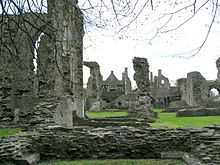Neath Abbey


Neath Abbey was a Cistercian monastery, located near the present-day town of Neath in South Wales, UK. It was once the largest abbey in Wales. Substantial ruins can still be seen, and are in the care of Cadw. Tudor historian John Leland called Neath Abbey "the fairest abbey of all Wales."
History
Neath Abbey was established in 1129 AD when Sir Richard de Granville, one of the Twelve Knights of Glamorgan, gave 8,000 acres (32 km²) of his estate in Glamorgan, Wales to Savigniac monks from western Normandy. The first monks arrived in 1130. Following the assumption of the Savigniac order into the Cistercian order in 1147, Neath Abbey also became a Cistercian house. The abbey was ravaged by the Welsh uprisings of the 13th century, and eventually dissolved by King Henry VIII of England in 1539. At this time, the abbey was turned into a large estate. Sir Philip Hobby was the last occupant of the estate.
Industrial use
By 1730, some of the buildings were being used for copper smelting, and the rest were abandoned. In the late 18th century, an Iron Foundry was opened near the Abbey ruins by a company owned by the Price, Fox and Tregelles families.
Later History
The freehold of the Abbey Ruins was given to the Crown by Communist Councillor on NRDC Alun Thomas. There were astounding repercussions. Len Wincott, who wrote "Invergordon Mutineer" about his part in that Mutiny lost the job he had been found in Russia by Alun, and was sent to a Gulag. It took about eight years to get him released.
There could perhaps be some Neath Abbey Village history here. In about 1939 the Neath Abbey branch of the Labour Party was expelled from the Labour Party for going into the United Front Against Fascism so that Alun Thomas was elected as an NRDC Councillor.
Archaeology
The archaeology of the abbey was eventually excavated between 1924 and 1935.
Commercial Use
The area is also currently used by Trade Centre Wales as the home of the largest selection of Used Cars in Wales, and was the former site of Town and Country Broadcasting before the re-located to the ITV Wales & West building in Culverhouse Cross.
It's also currently home to a number of smaller businesses and workshops.
The site has also been used to film several episodes of Dr Who. The Time Lord Matt Smith and his flame-haired assistant, Karen Gillan, have filmed several times at the crumbling site, which dates back to 1129 AD, and had been transformed into a complete structure for the sci-fi show.
Nearest places
See also
- Neath (UK Parliament constituency)
- Neath Abbey Castle Class steam locomotive
- List of Scheduled Monuments in Neath Port Talbot
External links
- www.EventPicture.co.uk : FREE pictures of Neath Abbey
- www.geograph.co.uk : photos of Neath Abbey
- Neath Abbey article from a website on Cistercian abbeys
- Castle Wales website with good illustrations
- Gathering the Jewels website on Welsh Cultural History - includes aerial photograph of the Abbey site
- Neath Abbey Ironworks
- Cistercian Way website - article on the Iron Works
- West Glamorgan Archives service- records relating to Neath Abbey
Coordinates: 51°39′39″N 3°49′35″W / 51.6609°N 3.8265°W
| |||||||||||||||||||||||||||||||||||||||||||||||||||||||